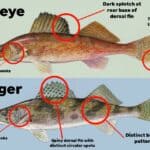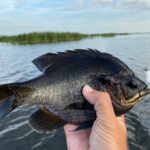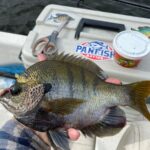When it comes to properly idetyfying small freshwater baitfish and forage fish, even the experts can easily get confused.
In this article, I’ll explain the difference between minnows vs shiners. I’ll talk a little about why these two terms are often interchanged, and how you can easily tell the difference out in the field.
Table of Contents
Minnows Vs Shiners: What’s the difference?
The word “Minnow” is a catch-all term that encompasses over two thousand different species of small freshwater fish. While all Shiner Fish are technically considered Minnows, they are among the largest species in the Minnow family, and are generally used in fishing to target larger gamefish.
Without getting too technical, all Shiners are part of the “Notropis” family of freshwater fish which include several Shiner species as well as the “Chub” family.
“True Minnows” can be members of hundreds of different species, and the “Common Minnow” is a Cyprinidae.
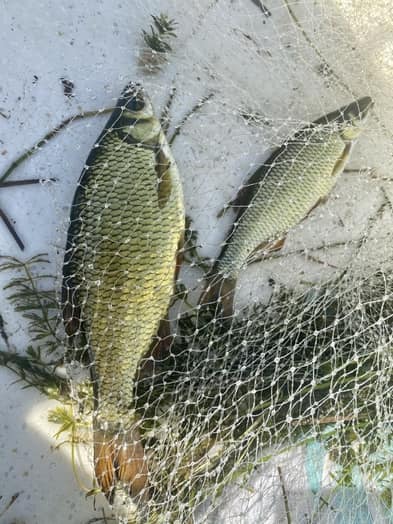
In other words, both the fishing terms minnow and shiner are used interchangeably to describe small, silver freshwater baitfish often associated with forage (or prey) for other fish, mammals, and amphibians.
What are Minnows?
Many anglers only consider “True Minnows” to be smaller species not exceeding three inches. The three most common types are Bluntnose Minnows, Fathead Minnows, and Mosquitofish. These smaller baitfish are commonly used for freshwater fishing and to stock ponds.
“True Minnows” can be solid as baitfish for anglers, and are also commonly used to stock lakes and ponds. Their smaller size makes them suitable bait for smaller game fish, and certain types of minnows are intentionally distributed across the world with the intention of mosquito control.
What are Shiners?
While technically part of the minnow family, Shiners are considerably larger than “True Minnows.” They are usually at least double the size of the common Bluntnose or Fathead Minnow, with the most common species being the Common, Emerald, and Golden Shiners.
Shiners are considerably larger than minnows and can measure up to ten inches. Their larger size makes them an ideal bait to catch gamefish like largemouth bass, pike, muskie, catfish, gar and much more.
They are plentiful in streams, lakes, ponds, rivers and even ditches across North America and are easily to catch as well as keep in tanks.
Why the confusion?
Shiners are technically a part of the Minnow family, which often causes confusion. While all Shiners are considered Minnows, not all Minnows are considered Shiners. The easiest way to tell them apart is by their size, as Shiners are usually double the size of Minnows.
Why Is It Important To Know The Difference?
Well, if you are anything like me and you love to fish, knowing the difference between minnows vs shiners is critical to choosing the correct bait.
For example, where I live in Florida the Golden Shiner is king when it comes to bait for largemouth bass.
Conversely, mosquitofish are an excellent bait choice for black crappie.
And Fathead minnows are often sold at bait shops but are not native to most of the areas I fish so they tend not to be a great bait choice.
Plus, if you decide to ever raise your own wild shiner or minnows for bait, or in an aquarium it’s important to know your species, rules, and biological composition!
Common Minnows and Shiners Used as Bait
While there are thousands of different species of small fish in the minnow family, there are a few species that dominate the bait fish industry. Mosquitofish, as well as Bluntnose and Fathead minnows are best for targeting smaller fish, while Shiners work better for catching larger fish.
Bluntnose Minnow
Commonly referred to as the “Common Minnow,” the Bluntnose Minnow is likely the most common freshwater fish found anywhere East of the Mississippi River. It is primarily silver in color, and is often found with a horizontal black or gray stripe across its body.
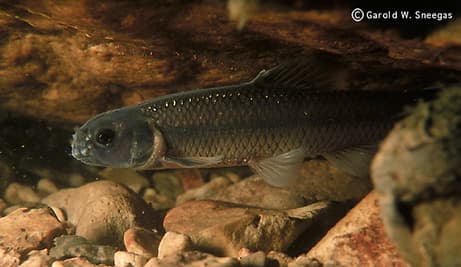
Bluntnose minnows only grow to between two and three inches, and are commonly used to stock ponds as bait for gamefish. They adapt easily to various water qualities and temperatures, and their natural predators include bass, trout, and pike.
Fathead Minnow
The Fathead Minnow is one of the most common feeder and bait fish sold across the United States as well as Canada. The most common species of Fathead sold commercially is the “Rosy-Red Minnow” and has an orange-red hue as the name suggests.
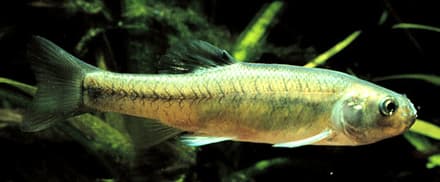
Fathead Minnows rarely grow to be larger than two and a half inches, and is one of the most common bait fish used to catch perch, small crappie, and walleye. Due to their small size and abundance, these are the most common Minnows used to target smaller game fish.
Mosquitofish
As the name suggests, the Mosquitofish loves to feed on mosquito larvae on the water’s surface. Mosquitofish have been used to naturally control the mosquito population by humans more than any other fish in the world, which has usually led to the decline of native fish species.
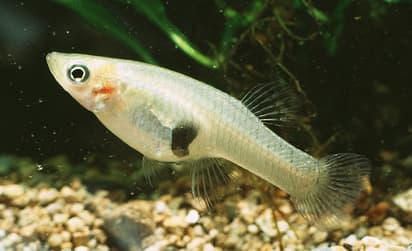
Mosquitofish generally only grow to between one and two inches, and should be used to target species too small for Bluntnose or Fathead Minnows. They are often the best bait to use when targeting bluegill, as well as small and medium sized bass.
Common Shiner
The Common Shiner can have either a bronze or silver color with a blue tint, and has a dark stripe across its dorsal area and rear. They are one of the most common types of baitfish in the world, and can be found in freshwater streams all across North America.
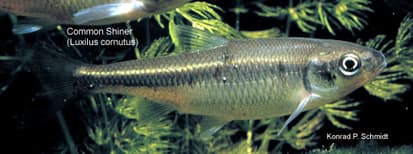
This common baitfish is significantly larger than its “True Minnow” counterparts, and usually measures between four and seven inches. This larger size makes them more suitable for catching large fish including pike, catfish, and largemouth bass.
Emerald Shiner
Emerald Shiners are very similar to the Common Shiner, with the addition of a greenish blue emerald-esque band that runs across its tail and behind its gills.

They are used to catch the same types of fish as the Common Shiner, and are also often aquarium kept for their coloration.
Golden Shiner
Golden Shiners are very unique in appearance compared to other Shiner fish, and feature a smokey band that runs along its side. This band fades with age, revealing more of their shiny gold coloration. They are also less round, and feature a thinner profile than other Shiners.
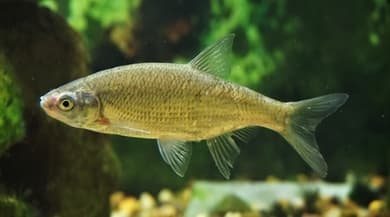
They usually measure between five and six inches, and are extremely common bait fish used to target bass. By many estimates, they are the most commonly bought and distributed baitifsh used to stock private ponds and lakes across the entire continent of North America.
I love golden shiners!
See Also: How To Keep Minnows Alive Without an Aerator (7 Tips)
If you haven’t guessed yet, I love fishing and everything about it!
To learn more about why I started Panfish Nation, visit the About page and follow along on Social Media:


Download a copy of my FREE Lure Color Selection Chart & Knot Guide!
Stay up to date with fishing reports, tackle reviews, industry news, and much more! We respect your privacy, unsubscribe at any time.
Related Posts
- Sauger vs Walleye: Learn These Differences and Catch More!
- Crazy Facts About the World Record Crappie
- What Size Hooks for Smallmouth Bass? Quick Guide
- Large and in Charge-Mouth: 10 of the Best Bass Lures of All Time (And Where to Buy Them)
- Emperor of the Sun(fish): What You Need to Know About the World Record Bluegill
- Coppernose Bluegills: How They’re Different from Common Bluegill

